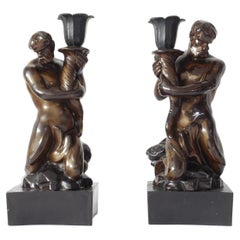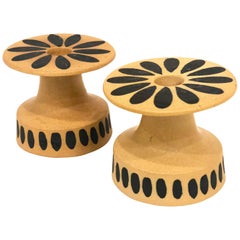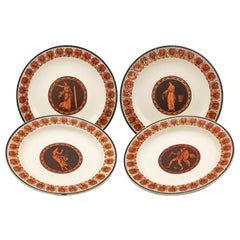Palmer Ceramics
to
1
1
1
1
1
1
1
1
1
1
1
1
1
318
204
184
131
Creator: Palmer
Pair of Triton Candlesticks. Palmer C1780.
By Palmer
Located in Melbourne, Victoria
An exceptionally rare pair of Triton candlesticks, in black basalt with gold lustre. The design is copied from Wedgwood, who took it from Sir Willi...
Category
Late 18th Century English Neoclassical Antique Palmer Ceramics
Materials
Stoneware
$6,000 Sale Price
20% Off
Related Items
Pair of Midcentury Ceramic Candlestick Holders by Bennington Potters
By Bennington Potters
Located in San Diego, CA
Beautiful and rare pair of ceramic candleholders by Bennington Potters, in beautiful condition nice color and design. In mustard and black design.
Category
20th Century American Mid-Century Modern Palmer Ceramics
Materials
Ceramic
$220 Sale Price / set
20% Off
H 3.5 in Dm 4.5 in
Early Wedgwood Neoclassical Creamware Dessert Dishes Made circa 1780
By Wedgwood
Located in Fort Lauderdale, FL
A set of four early Wedgwood creamware Neoclassical dessert dishes made circa 1780.
Sir William Hamilton’s Collection of Etruscan, Greek and Roman an...
Category
Late 18th Century English Neoclassical Antique Palmer Ceramics
Materials
Creamware
Vallauris Pair of Candlesticks, 1940s
By André Baud
Located in Saint-Amans-des-Cots, FR
Pair of candlesticks made at Vallauris, France, 1940s. Ceramic. Representation of braided candlesticks, Classic design from this period of the 40s. Very close to the work of Jérome M...
Category
1940s French Neoclassical Vintage Palmer Ceramics
Materials
Ceramic
Italian Maiolica Ancient Tureen, Lodi, 1770-1780
By Antonio Ferretti
Located in Milano, IT
Maiolica tureen
Antonio Ferretti Manufacture
Lodi, circa 1770-1780
Maiolica polychrome decorated “a piccolo fuoco” (third fire).
It measures 9.05 x 12.59 x 9.05 in (23 x 32 x 23 cm)
...
Category
1770s Italian Rococo Antique Palmer Ceramics
Materials
Maiolica
Pair of Antique English Creamware Tulipieres or Flower Vases 18th Century c.1780
By Neale & Co.
Located in Katonah, NY
This elegant pair of English creamware flower vases, tulipieres, by Neale & Co. exemplifies the artistry and sophistication of late 18th-century English Neoclassical design.
The form...
Category
Late 18th Century English Neoclassical Antique Palmer Ceramics
Materials
Creamware
$2,800 / set
H 7.5 in W 4.5 in D 4.5 in
Ashby Potters Guild Pair Art Nouveau Streak Glazed Candlesticks
Located in Bishop's Stortford, Hertfordshire
An exceptional pair of Art Nouveau purple and blue streak glazed art pottery candlesticks dating between 1909 and 1922. The stoneware candlesticks are heavily potted standing on wide rounded bases with tall graduating column stems with bud shaped tops with flat rounded rims. The candlesticks are decorated in streaked blue and purple glazes over a lighter red glazed ground and both have clear glazed foot rims with recessed bases. The candlesticks are both impressed ASHBY GUILD...
Category
Early 20th Century English Art Nouveau Palmer Ceramics
Materials
Ceramic, Stoneware
Rare Pair of Gold and White Candlesticks, Waylande Gregory
By Waylande Gregory
Located in Philadelphia, PA
This rare pair of porcelain candlesticks, brilliantly glazed in gold and white, are signed by Waylande Gregory, the pioneering 20th century sculptor and ceramicist. Prodigious and i...
Category
1950s American Art Deco Vintage Palmer Ceramics
Materials
Porcelain
$880 Sale Price / set
20% Off
H 1.88 in Dm 4 in
Italian Maiolica Ancient Sugar Bowl, Lodi, 1770-1780
By Antonio Ferretti
Located in Milano, IT
Maiolica sugar bowl
Antonio Ferretti Manufacture
Lodi, Circa 1770-1780
Maiolica polychrome decorated “a piccolo fuoco” (third fire).
It measures 3.54 x 4.52 x 3.54 in (9 x 11,5 x 9 cm)
Weight: 0.394 lb (0.179 kg)
State of conservation: small and slight chips on the edges.
The small sugar bowl has a swollen and ribbed body resting on a flat base. The cap-shaped lid follows the rib of the container and is topped with a small knob in the shape of a two-colored fruit.
The sugar bowl is painted “a piccolo fuoco” (third fire) with the characteristic floral motif of bunches and isolated semis.
An example which closely corresponds to this one is kept at the Civic Museum in Lodi (G. Gregorietti, Maioliche di Lodi, Milano e Pavia, Catalogo della Mostra, Milano, 1964 n. 137).
This decorative style represented a strong point of the Lodi factory, which established itself thanks to the vivid nature of the colors made possible by the introduction of a new technique perfected by Paul Hannong in Strasbourg and later introduced by Antonio Ferretti to Italy. The production process, called “piccolo fuoco” (third fire), allowed the use of a greater number of colors than in the past; in particular, the purple of Cassius, a red made from gold chloride, was introduced. Its use allowed for many more tones and shades, from pink to purple.
The Ferretti family started their maiolica manufacturing business in Lodi in 1725.
The forefather Simpliciano started the business by purchasing an ancient furnace in 1725 and, indeed, we have evidence of the full activity of the furnaces starting from April of the same year (Novasconi-Ferrari-Corvi, 1964, p. 26 n. 4). Simpliciano started a production of excellence also thanks to the ownership of clay quarries in Stradella, not far from Pavia. The production was so successful that in 1726 a decree of the Turin Chamber came to prohibit the importation of foreign ceramics, especially from Lodi, to protect internal production (G. Lise, La ceramica a Lodi, Lodi 1981, p. 59).
In its initial stages, the manufacture produced maolicas painted with the “a gran fuoco” (double fire) technique, often in turquoise monochrome, with ornamentation derived from compositional modules in vogue in Rouen in France. This was also thanks to the collaboration of painters like Giorgio Giacinto Rossetti, who placed his name on the best specimens next to the initials of the factory.
In 1748 Simpliciano made his will (Gelmini, 1995, p. 30) appointing his son Giuseppe Antonio (known as Antonio) as universal heir. After 1750, when Simpliciano passed away, Antonio was directly involved in the maiolica factory, increasing its fortunes and achieving a reputation on a European level. Particularly important was the aforementioned introduction in 1760 of the innovative “a piccolo fuoco” (third fire) processing, which, expanding the ornamental repertoire with Saxon-inspired floral themes, was able to commercially compete with the German porcelains that had one of its most renowned offerings in the naturalistic Deutsche Blumen. Antonio Ferretti understood and promoted this technique and this decoration, proposing it in a fresher and more corrective version, less linked to botanical tables, both with or without contour lines, as well as in purple or green monochrome. After efforts to introduce more industrial production techniques to the sector succeeded, even the Ferretti manufacture, in the last decade of the eighteenth century, started heading towards decline despite its attempts to adapt production to neoclassical tastes.
In 1796 the Napoleonic battle for the conquest of the Lodi bridge over the Adda definitively compromised the furnaces. Production resumed, albeit in a rather stunted manner, until Antonio's death on 29 December 1810. (M. L. Gelmini, pp. 28-30, 38, 43 sgg., 130-136 (for Simpliciano); pp. 31 sgg., 45-47, 142-192 (for Antonio).
Bibliography
G. Gregorietti, Maioliche di Lodi Milano e Pavia Catalogo della Mostra, Milano, 1964 n. 137;
C. Baroni, Storia delle ceramiche nel Lodigiano, in Archivio storico per la città e i comuni del circondario e della diocesi di Lodi, XXXIV (1915), pp. 118, 124, 142; XXXV (1916), pp. 5-8;
C. Baroni, La maiolica antica di Lodi, in Archivio storico lombardo, LVIII (1931), pp. 453-455;
L. Ciboldi, La maiolica lodigiana, in Archivio storico lodigiano, LXXX (1953), pp. 25 sgg.;
S. Levy, Maioliche settecentesche lombarde e venete, Milano 1962, pp. 17 sgg.;
A. Novasconi - S. Ferrari - S. Corvi, La ceramica lodigiana, Lodi 1964, ad Indicem; Maioliche di Lodi, Milano e Pavia (catal.), Milano 1964, p. 17;
O. Ferrari - G. Scavizzi, Maioliche italiane del Seicento e del Settecento, Milano 1965, pp. 26 sgg.;
G. C. Sciolla, Lodi. Museo civico, Bologna 1977, pp. 69-85 passim; G. Lise, La ceramica a Lodi, Lodi 1981;
M. Vitali, in Storia dell'arte ceramica...
Category
1770s Italian Rococo Antique Palmer Ceramics
Materials
Maiolica
Pair Meissen Style Creamware Dishes 18th Century England Hand Painted Circa 1780
Located in Katonah, NY
This is a pair of English creamware dishes from the 18th century, created around 1780. The plates display a lovely chinoiserie scene in the Meissen style, with women selecting access...
Category
Late 18th Century English Chinoiserie Antique Palmer Ceramics
Materials
Creamware
$520 / set
H 1 in Dm 9.5 in
Gustavsberg a Pair of Unglazed Candlesticks, app. 1960s
By Stig Lindberg
Located in København, Copenhagen
Gustavsberg. A pair of unglazed candlesticks in stoneware.
Approximately 1960.
Marked.
Measures 13 cm.
In perfect condition.
Category
1960s Swedish Scandinavian Modern Vintage Palmer Ceramics
$208 Sale Price / set
42% Off
H 5.12 in Dm 1.97 in
Italian Maiolica Cup Ferretti Lodi, circa 1770 - 1780
By Antonio Ferretti
Located in Milano, IT
Maiolica puerperal cup
Antonio Ferretti Manufacture
Lodi, Circa 1770 - 1780
Maiolica polychrome decorated “a piccolo fuoco” (third fire).
It measures: 4.3 x 6.8 x 5.3 in (11 x 17,5 x 13,5 cm)
Weight: 0.78 lb (358 g)
State of conservation: some closed pass-through fêlures on the cup, barely visible on the outside. Some use chips on the edge of the lid, two of which are more marked.
From about the mid-sixteenth century, the puerperal soup tureen or puerperal cup became one of the most popular wedding gifts in central Italy. As an auspicious symbol, it replaced the birth table (“desco da parto”) which, on the occasion of high-ranking marriages, from the thirteenth century, had been painted by famous artists, especially in Tuscany.
In France this same tureen is called "écuelle de mariée", as it is given to spouses as a sign of fertility.
During the eighteenth century this custom spread even outside Italy to all social levels. Depending on availability and rank, it was made of different materials: precious metals, maiolica, porcelain, glass, pewter, etc.
Beginning in the mid-twentieth century, the custom of this symbolic homage gradually disappeared, although famous designers such as Gio Ponti and Giuseppe Gariboldi, even as recently as the 1940s, revisited a model of a small puerperal soup bowl for the Ginori and, also in Italy in 1940, in a national competition for young potters, one of the themes of the test was indeed a modern model of a puerperal cup as an auspicious gift.
This particular cup was also called a "service cup" or "puerperal vase" or "stuffed cup" - the windows were sealed with straw to prevent drafts of air for women in labor.
In the eighteenth century the line of the puerpera cup was simplified, so much so that it took the form of a small tureen with two handles - the typical broth cup...
Category
1770s Italian Rococo Antique Palmer Ceramics
Materials
Maiolica
Pair of Italian Maiolica Tureens, Ferretti Manufacture, Lodi Circa 1770 - 1780
By Antonio Ferretti
Located in Milano, IT
Pair of maiolica tureens
Antonio Ferretti Manufacture
Lodi, circa 1770-1780
Maiolica polychrome decorated “a piccolo fuoco” (third fire).
a – 8.66 x 11.02 x 7.48 in (22 x 28 x 19...
Category
1770s Italian Rococo Antique Palmer Ceramics
Materials
Maiolica
$14,207 / set
H 8.86 in W 12.21 in D 7.88 in
Palmer ceramics for sale on 1stDibs.
Palmer ceramics are available for sale on 1stDibs. These distinctive items are frequently made of stoneware and are designed with extraordinary care. There are many options to choose from in our collection of Palmer ceramics, although black editions of this piece are particularly popular. Many of the original ceramics by Palmer were created in the neoclassical style in united kingdom during the 18th century and earlier. If you’re looking for additional options, many customers also consider ceramics by Wedgwood, and Wedgewood. Prices for Palmer ceramics can differ depending upon size, time period and other attributes — on 1stDibs, these items begin at $7,500 and can go as high as $7,500, while a piece like these, on average, fetch $7,500.
Questions About Palmer Ceramics
- 1stDibs ExpertJanuary 10, 2025The meaning of Avery Palmer's paintings varies depending on the work and is open to interpretation. When describing his work, Palmer has stated that it "seeks to explore the nature of humanity and express the inherent complexity and mystery of our relationships to the world we live in and each other.” Over the years, the artist has cited influences that include Old Masters paintings, the work of Surrealist Salvador Dalí, and comics by underground artist Robert Crumb. On 1stDibs, shop an assortment of Avery Palmer art.


